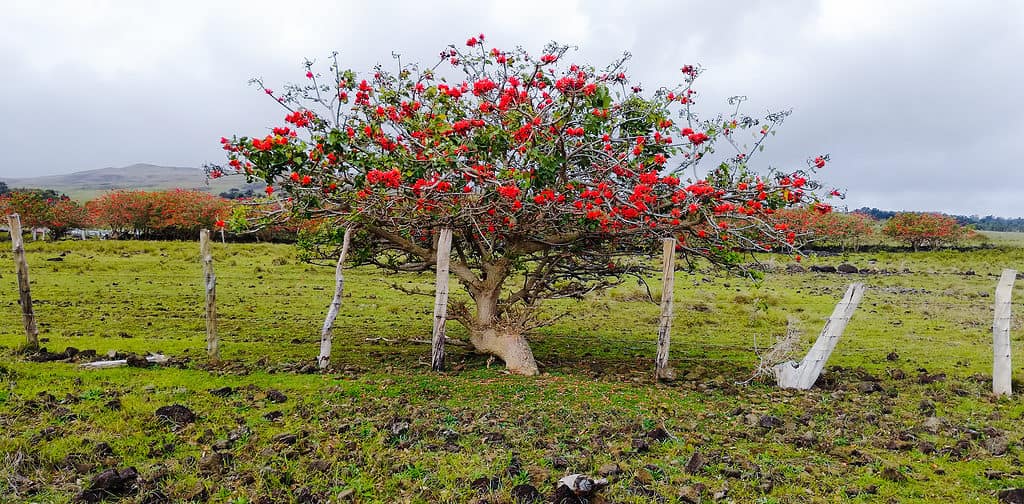Uruguay is a small South American country located between Brazil and Argentina. It has an area of about 68,000 square miles and is bordered by the Atlantic Ocean to the east. Uruguay is home to 2,500 native plants, many of which grow wild across the country. Among those are various species of Erythrina trees. And, yes, the national flower of Uruguay is Ceibo Erythrina, a species of Erythrina.
Geography and Climate of Uruguay
Uruguay’s terrain predominantly consists of rolling hills, grasslands, and wooded areas. The majority of Uruguayan rivers flow into either Rio de la Plata or Laguna Merin, which are large saltwater estuaries that form part of their shared border with Argentina. There are also freshwater lakes, including Lake Solis, which lies within a national park on the western side of the country known as Parque Nacional Santa Teresa. Visitors can admire nature reserves and parks full of flora and fauna throughout Uruguay. The climate is temperate, with hot summers and mild winters. Most of the population lives along the coast due to its rich soil for farming or near Montevideo, which is the capital city.
The National Flower: Ceibo Erythrina
The people of Uruguay recognize the Ceibo Erythrina or Erythrina crista-galli as their national flower. This flowering tree is native to South America, more specifically to Uruguay, Argentina, Brazil, and Paraguay. It thrives in gallery forest ecosystems along watercourses, as well as in swamps and wetlands. It can reach 33 feet in height. From October to April, its distinctive red blossoms bloom, symbolizing love and attraction to the citizens of Uruguay. This beautiful flower is found growing throughout the country and is also Argentina’s national flower.
Common Names of Ceibo Erythrina
The Ceibo Erythrina can be referred to by different names in different countries. In Spanish, it’s called seibo. In Portuguese, it is referred to as corticeira and bucaré. The Latin-derived epithet crista-galli translates to ‘cock’s comb’ in English, hence the nickname “cockspur coral tree.” This name comes from the shape of the striking red flowers that decorate this spectacular species.
What is Ceibo Erythrina?
The Ceibo Erythrina, also called the “cockspur coral tree,” is a vibrant flowering tree of the pea family. The clusters of bright red flowers with yellow stamens appear at the end of the branches in late winter or early spring. They are attractive to pollinator insects such as bees and butterflies. The long, black seedheads come after the flowers and provide another season of interest. The bark of this species is quite remarkable with its rough texture and vertical fissures giving it a spiky appearance that makes it stand out from other trees.

.
©Eny Strawberry/Shutterstock.com
Do Animals Eat Ceibo Erythrina?
The Ceibo Erythrina tree is an important home for various animals, supplying them with shelter and energy through its sweet-smelling blossoms and nutritious seeds. In addition, creatures such as insects and hummingbirds find sustenance in the flower’s nectar-filled petals. The pollen of the ceibo flower assists in maintaining a diverse environment. Pollinators travel between plants, enabling cross-pollination and seed production. Additionally, several bird species in the area utilize the plant matter of ceibo erythrina trees to construct their nests.
How to Grow a Ceibo Erythrina
Cultivating a Ceibo Erythrina tree is fairly simple and can be accomplished in most climates if the proper requirements are met. It is the happiest outdoors in USDA Hardiness zones 9-11. That is why this plant is also becoming popular in the warm southern states of the U.S. and can be found in the gardens and streets of California. However, if you live outside of those regions, it can be grown in a container and brought in during the cold season. Additionally, it will also do well in a spacious greenhouse.
For those who want to grow the national flower of Uruguay, it is best to purchase a young sapling of Ceibo Erythrina from a nursery or online vendor. Plant it in soil with plenty of nutrients and good drainage, and ensure it receives direct sunlight daily. It is important to give the tree enough space to grow. They can reach up to 33 feet tall and nearly 15 feet wide, so be sure to plant them at least 10 feet away from other trees or structures. Monitor the amount of water given to your Ceibo Erythrina and make sure it gets just enough. If planted correctly, these flowers are able to withstand periods of drought. Pruning may be necessary if you would like your ceibo to have a particular shape or appearance. Trimming away dead or unhealthy branches will help keep them healthy and promote new growth.

©Valerio Bonaretti/Shutterstock.com
Other Native Plants of Uruguay
Other popular native plants include peperomia, ferns, palm trees, and prairies full of tall pampas grass. Uruguay also has a wide variety of native grasses, including king grass and Parana grass. Nearly 80 percent of Uruguay is prairie grasslands, so these native grasses are essential to the local ecosystem.
Various wildflowers grow in the wild, such as exotic orchids like Laelia rubescens and ferns like Blechnum palmiforme. Common wildflowers in Uruguay include the white-flowered cattail, lavender cotton, and yellow poppy. You can also find large areas with wild parrot lilies and passion flowers. There is also the beautiful striped milk pea and many species of bromeliad. These flowers are often seen growing along roadsides, in dunes and wetlands, or on riverbanks throughout the country. They add vibrancy to Uruguay’s landscape and attract birds, butterflies, and other wildlife.
Up Next:
- The Flag of Uruguay: History, Meaning, and Symbolism
- 10 Countries With Blue and White Flags, All Listed
- Meet The Largest South American Bird
- Discover the 5 Birds That Lay Eggs in Other Birds’ Nests
The post Discover The National Flower of Uruguay: Ceibo Erythrina appeared first on AZ Animals.
from Animal News, Facts, Rankings, and More! - AZ Animals https://ift.tt/1cPFk6l